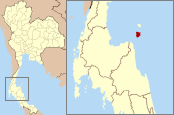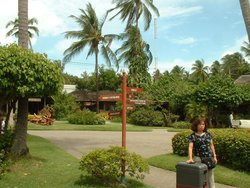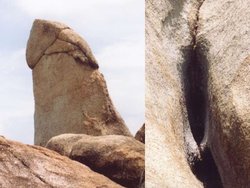Ko Samui
|
|
KoSamuiNaThonFromJungle_OwlofDoom.jpg
Ko Samui (or Koh Samui, Thai เกาะสมุย) is an island off the east coast of the Kra Isthmus in Thailand, close to the mainland Surat Thani town. It has an area of 228.7 km² and a population of 45,873 (2004).
| Contents |
History
The island was probably first inhabited about 15 centuries ago, settled by fishermen from Malaysia and Southern China. It appears on Ming Dynasty maps dating back to 1687, under the name Pulo Cornam. The name Samui is mysterious in itself. Perhaps it is an extension of the name of one of the native trees, mui, or it is a corruption of the Chinese word Saboey, meaning "safe haven".
Until the late 20th century, Samui was an isolated self-sufficient community, having little connection with the mainland of Thailand. The island was even without roads until the early 1970s, and the 15km journey from one side of the island to the other involved a whole-day trek through the mountainous central jungles.
Today, Samui has a population of about forty-five thousand, and lives on a successful tourist industry, as well as exports of coconut and rubber. It even has its own international airport, with flights daily to Bangkok and other major airports in Southeast Asia. It has not forgotten its roots, however, and the people are still by-and-large the same easygoing island folk they were before the world landed on their doorstep.
Geography
Koh_Samui_Lipa_Noi2.jpg
Samui is located in the Gulf of Thailand, about 35km northeast of Surat Thani town (9°N, 100°E). It is surrounded by about sixty other islands, most of which comprise the Ang Thong National Marine Park, but also include other tourist destinations Ko Pha Ngan, Ko Tao and Ko Nang Yuan.
The island is roughly circular in shape, and is about 15km across. The central part of the island is an (almost) uninhabitable mountain jungle (peak Khao Pom, 635m) and the various lowland areas are connected together by a single road, that covers the circumference of the island.
There is one town, Na Thon, on the west coast of the island, with a major port for fishing and inter-island transportation. Each of Samui's many beaches is also nominally considered a town, due to the number of hotels, restaurants and bars that have sprung up in recent years.
Administration
Administratively, Ko Samui is an Amphoe (district) of the Surat Thani province. The district is subdivided into 7 tambon:
- Ang Thong
- Li Pa Noi
- Taling Ngam
- Na Mueang
- Ma Ret
- Bo Phut
- Maenam
Economy
Historically the island's economy has been based around subsistence agriculture and fishing, although coconuts also play a role as a cash crop. From the 1980s onwards however, tourism has become an economic factor and is now the dominant industry. The construction of a stable, high-speed internet connection in recent years has also made the island a practicable location for IT-based enterprises, which are beginning to provide a certain degree of economic diversity. The island's climate and accesibility make it particularly attractive for international investors.
Beaches
Samui is mostly visited by holidaymakers wanting to "get away from it all", so its main appeal is its white beaches and warm sea, and it has plenty to choose from.
KoSamuiChoengMonBeach_OwlofDoom.jpg
Big_Buddha.jpg
The three beaches that comprise Chaweng cover most of the island's east coast, and form the most popular tourist destination on the island. The beach itself has kept its idyllic beauty, despite the vast number of visitors that occupy it year-round. The nearby ring-road, however, has built up a huge Western-style tourist town, packed full of restaurants and bars (ranging from traditional family-run Thai at Ninja, through Thai-Californian fusion food at Betelnut to McDonald's and even Starbucks), souvenir shops, markets and nightclubs. It can get very busy on the road at night, both with truck-taxis carrying people up and down the coast and with people exploring the shopping (which stays open late) and nightlife.
Lamai is Samui's second beach. It is much smaller than Chaweng, but its sands are just as pretty. As with Chaweng, it can get very packed with people, and it has a reputation as the home of Samui's seedier nightlife.
The first of three beaches on the North coast of the island, Maenam is the cheapest of Samui's resorts, as the beach is more exposed and less beautiful that Chaweng or Lamai. It is quieter and enjoys beautiful views, but still suffers a little from the tourist bug.
Bophut is the next beach along from Maenam. Its lifestyle is relaxed and more traditional than the larger beaches, referring to itself as Fisherman's Village. It is very popular with French tourists, and has a number of good restaurants of French proprietary.
Bangrak is often known by the name Big Buddha Beach, after the 19-metre statue of the man that overlooks the area (Big Budha). Bangrak is very close to the airport, but is small and unexciting as a location.
Choeng Mon is the smallest of Samui's tourist beaches, but lies in a secluded bay on the northeastern tip of the island, making it perfect for those who want peace and quiet, and warm sea all day. It does not have a town, but there are a number of small restaurants and a couple of shops, in addition to the luxurious (and expensive) hotels that surround the bay, and it is only five minutes from the bright lights of Chaweng.
Tourist attractions
- Big Buddha is a twelve-metre high statue of the Buddha, which lies at the top of ceremonial dragon-steps at the Wat Phra Yai. Samui also has a number of other impressive temples, including Wat Khunaram, where the mummified body of Loung Pordaeng, a monk who died in a meditating position, is on display.
- The Grandmother and Grandfather rocks close to Lamai beach are an occasional source of amusement for tourists, due to their striking similarity to human genitalia, female and male respectively.
- The mountain jungle in the interior of the island is an excellent day out, and is home to a number of impressive gardens built by legendary Samuian farmer Nim Thongsuk, the impressive waterfalls at Na Muang, real working rubber plantations and the most amazing views over the Ang Thong archipelago. The roads in the jungle are an adventure in themselves, and tourists normally take a tour with an experienced Samuian driver.
- Muay Thai boxing takes place regularly at the island's stadium in Chaweng.
- Numerous animal attractions are dotted around the island, including a crocodile farm, monkey theatre, elephant trekking, a snake farm, an aquarium and a butterfly garden.
- Most visitors to the island take a day trip out to the beautiful Ang Thong National Marine Park at least once on their stay in Samui. Boats leave Na Thon several times a day.
- Ko Pha Ngan has a full-moon party at the appropriate time each lunar month, and tourists in Samui often jump on a boat to the nearby island to join in the fun.
See also
External links
- Samui.org (http://samui.org)
- map of Ko Samui (http://map-samui.com)
- Samui tourism association (http://www.samuitourism.com/)
- Ko Samui travel guide (http://www.inm-asiaguides.com/thailand/kohsamui/esamintr.htm)
- Thailand islands portal (http://www.kohsamui.org)
- Ko Samui Online (http://www.kosamuithailand.info)
Template:Amphoe Surat Thanide:Samui fr:Ko Samui ja:サムイ島 no:Ko Samui sv:Koh Samui



